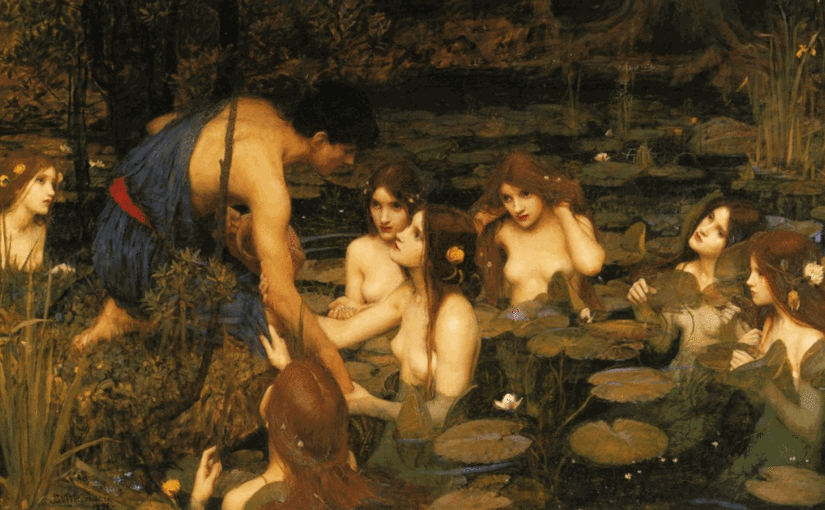John William Waterhouse was an amazing artist that produced at least 180 artworks during his career. He is considered to be a “English , Victorian Romanticist painter and draftsman”. He was born in 1849 and Died on 2/10/1917.
You can see his entire collection on the Art Renewal Center here.
Like my post on Lawrence Alma-Tadema, you might want to consider this post to be an excurion into Greek mythology and Roman history through the artwork of renessance painters in Europe.
The Lady of Shalott
I have often admired this painting but really had little understanding about what was so appealing about it. To me, it was a sad woman in boat, alone and drifting off into the mists.
This painting depicted an event or circumstance that was described in a poem.
"The Lady of Shalott" is a lyrical ballad by the English poet Alfred, Lord Tennyson (1809–1892). It tells the story of a young noble woman imprisoned in a tower on an island near Camelot. -The Lady of Shalott - Wikipedia
This poem depicted a sad and forlorn woman who was locked up and who had little freedom. That lack of freeom and the imprisonment was not obvious to anyone but herself.
During the period of the 19th century in which “The Lady of Shalott” poem was written, women were not treated in the same way that they are today. History tells us the story of how women came to be “equal” to men, yet when reading this poem, we see that this was not the case for the Lady of Shalott.
The women during this period were seen more as a possession rather than a person or a partner to a male. They were kept in the house and were sometimes not allowed to go outside and socialize. We see this neglect of women demonstrated many times throughout Tennyson’s poem.
Kept as a sort of prisoner in a building, or castle, on the secluded island of Shalott, the Lady of Shalott is described as a “fairy” woman who has been cursed.
For me, I could see this situation. Not only for the woman, in that time and plce, but for anyone who is trapped in a situation that they cannot get out of easily…

Links…
- Smart Histry Discusses the art behind this painting.
- Alfred Lord Tennyson. “The Lady of Shallot”. Poem
- Elizabeth Nelson. “Pictorial Interpretations of “The Lady of Shalott”: The Lady in her Boat.” Adapted from the author’s “Tennyson and the Ladies of Shalott, Ladies of Shalott: A Victorian Masterpiece and its Contexts”, Victorian Web(1979)
Consulting the Oracle
An oracle is a priest or priestess acting as a medium through whom advice or prophecy was sought from the gods in classical antiquity. -Dictionary.com
There were many other oracles in Greece, but the Oracle at Delphi was the most famous, and everyone who could afford to consult the Oracle at Delphi preferred to do so.
Of course, there was a long waiting period to consult the oracle (sometimes several months), and there were a number of expensive, preliminary sacrifices. Most of the people who consulted the Oracle at Delphi were wealthy individuals or even heads of state.
The long path leading up the mountain to Apollo’s temple, called the Sacred Way, was lined with treasure houses. These treasuries were filled with costly gifts that leaders and cities had given to Apollo. Some of these treasuries are still standing, and a very few of those precious gifts can still be seen in the museum at Delphi.
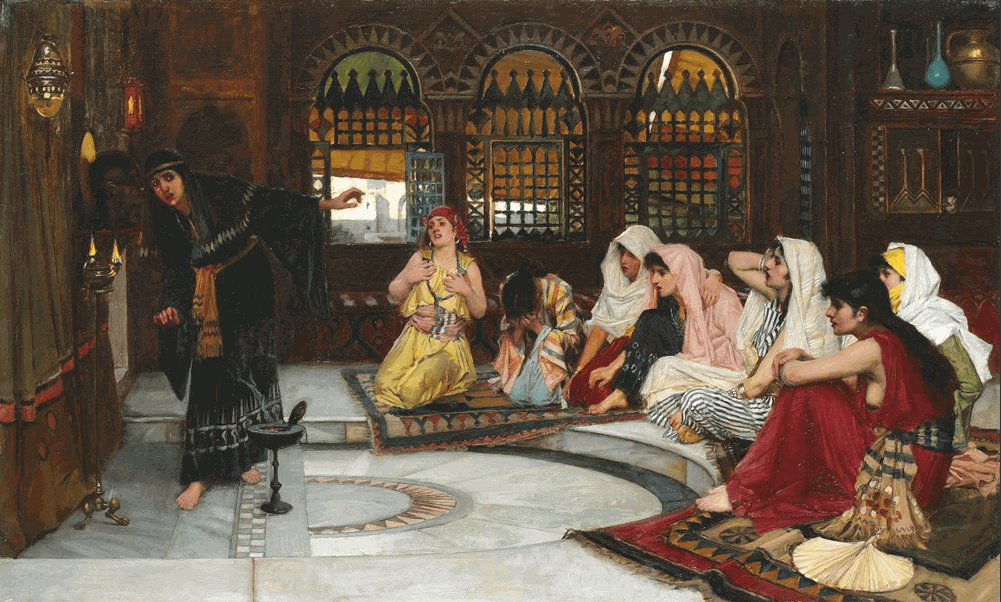
When someone came to ask a question of the Oracle, he would need to make a preliminary sacrifice of a goat, and then purify himself in the nearby Castilian Spring.
Then he would approach the adyton of Apollo’s temple.
The adyton is a room inside the temple that was off limits; no one could go in. It is unclear whether those who were consulting the oracle were allowed to go inside the adyton, or whether they had to remain outside.
The Pythia is usually conceived of as sitting on a tripod when she gave her prophecies.
A tripod (as its name implies) was a three-footed stand, usually made of metal. Tripods had a round, metal band around the top, and they were usually used to hold a cauldron over the fire for cooking. But in this case, the Pythia would sit on it, almost like she was sitting on a three-legged stool, to give her prophecies.
In the painting we see this tripod in use at the center of the room, but the oracle is not sitting on it.
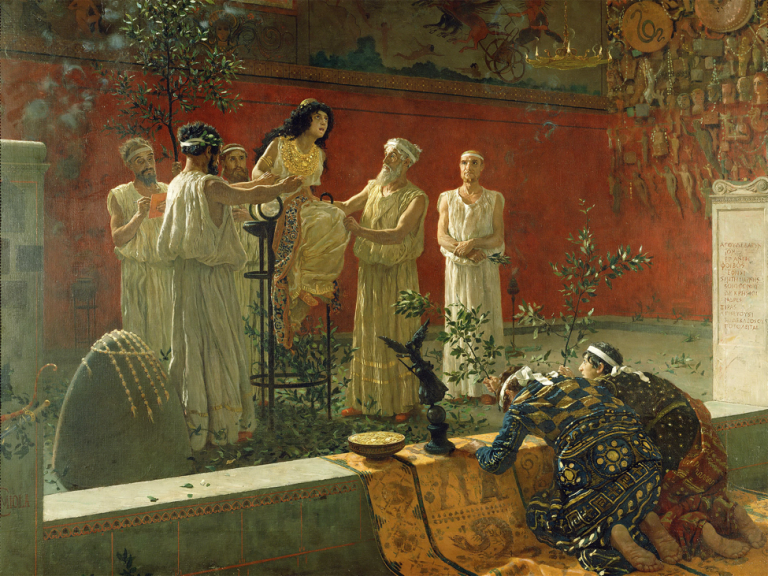
After the person consulting the Oracle asked his question, the Pythia would go into a trance; it was believed that Apollo himself possessed her.
She would speak and a priest (or several priests) who were standing near-by would take down what she said and translate her words into a poem written in hexameters.
It is usually assumed that the Pythia’s original words were coherent, but not very clear. Of course, there is no way to know for sure what her words were really like, but perhaps we can get a good idea from Cassandra’s prophecies in Aeschylus’ play, the Agamemnon.
In that play, Cassandra gives several prophecies that make sense to the audience (because we know what is going to happen), but are so fragmented and confusing that the other characters in the drama do not understand them.
Once the Pythia’s words were translated into hexameter poetry, the poem was written down and given to the person who sought the advice; it was always the responsibility of the recipient to interpret the oracle correctly.
And the oracles, even in their final form, were always ambiguous. Frequently (though not always), the recipients did not interpret them correctly, and they suffered as a result.
Saint Cecilia
This is a true story that actually happened. As a result, the woman in the story became a Catholic Saint. As such, the story of St. Cecilia is not without beauty or merit. She is said to have been quite close to God and prayed often:
In the city of Rome there was a virgin named Cecilia, who came from an extremely rich family and was given in marriage to a youth named Valerian. She wore sackcloth next to her skin, fasted, and invoked the saints, angels, and virgins, beseeching them to guard her virginity
During her wedding ceremony she was said to have sung in her heart to God and before the consummation of her nuptials, she told her husband she had taken a vow of virginity and had an angel protecting her. Valerian asked to see the angel as proof, and Cecilia told him he would have eyes to see once he traveled to the third milestone on the Via Appia (Appian Way) and was baptized by Pope Urbanus.
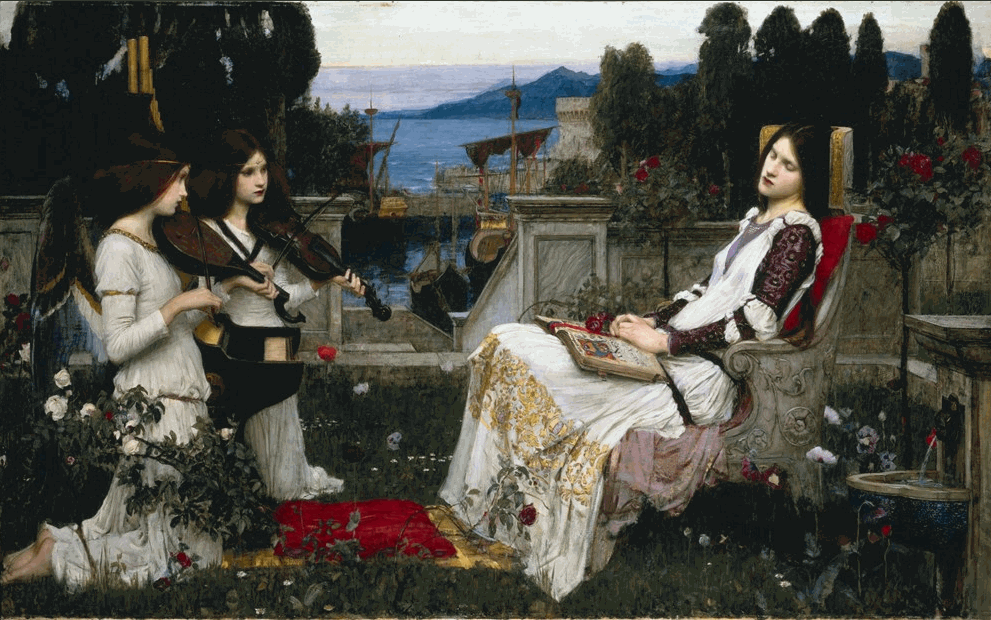
Following his baptism, Valerian returned to his wife and found an angel at her side. The angel then crowned Cecilia with a chaplet of rose and lily and when Valerian’s brother, Tibertius, heard of the angel and his brother’s baptism, he also was baptized and together the brothers dedicated their lives to burying the saints who were murdered each day by the prefect of the city, Turcius Almachius.
Both brothers were eventually arrested and brought before the prefect where they were executed after they refused to offer a sacrifice to the gods.
As her husband and brother-in-law buried the dead, St. Cecilia spent her time preaching and in her lifetime was able to convert over four hundred people, most of whom were baptized by Pope Urban.
Cecilia was later arrested and condemned to be suffocated in the baths. She was shut in for one night and one day, as fires were heaped up and stoked to a terrifying heat – but Cecilia did not even sweat.
When Almachius heard this, he sent an executioner to cut off her head in the baths.
The executioner struck her three times but was unable to decapitate her so he left her bleeding and she lived for three days. Crowds came to her and collected her blood while she preached to them or prayed. On the third day she died and was buried by Pope Urban and his deacons.
St. Cecilia is regarded as the patroness of music, because she heard heavenly music in her heart when she was married, and is represented in art with an organ or organ-pipes in her hand.
Officials exhumed her body in 1599 and found her to be incorrupt, the first of all incurrupt saints. She was draped in a silk veil and wore a gold embroidered dress. Officials only looked through the veil in an act of holy reverence and made no further examinations. They also reported a “mysterious and delightful flower-like odor which proceeded from the coffin.”
The church viewed this as a measure of sanctity, and incorruptibles -- people whose bodies mysteriously thwart decay -- were canonized into the tenets of Catholic mysticism. Incorruptibility became a component of beatification -- the process of becoming sainted. -How can a corpse be incorruptible?
St. Cecilia’s remains were transferred to Cecilia’s titular church in Trastevere and placed under the high altar.
The Favourites of the Emperor Honorious
Flavius Honorius was born in the east in 384, the younger son of the emperor Theodosius I (379-395) and Aelia Flavia Flaccilla. In his youth he was named Most Noble Child (nobilissimus puer), and in 386 he held the consulate. He was summoned by his father to Rome when he was five, but in 391 he returned with him to Constantinople, where in 393 he was proclaimed emperor of Rome.
After the Visigothic invasion of Italy in 402, Honorius and the imperial court retired from Milan to the inaccessible and heavily defended city of Ravenna.
Only rarely did later emperors reside for any length of time elsewhere.
Meanwhile, palace intrigues resulted in Stilicho’s assassination in 408, and Honorius was left to deal with barbarians Alaric and the Visigoths.
The indecisive emperor, influenced first by one adviser and then by another, vacillated between resistance and conciliation. The end result was the sack of Rome in 410.

Here we see a painting of the emperior playing idily with pigeons while Rome collapses all around him.
As for the feckless and timid Honorius, he generally took little part in public affairs. He was generally passive in nature, except when he was motivated to act by fear. He left military operations to his generals, but he did become involved in a controversy over the choice of a bishop of Rome in 418. He eventually died of "dropsy" -- perhaps edema of the lungs -- in 423. He left no issue, which resulted in the proclamation of Johannes, the Chief Secretary, after his death. Not until 425 did his nephew Valentinian III, the son of Galla Placidia and Constantius, restore the legitimate dynasty. Even though the unity of the western empire was shakily maintained during Honorius' reign -- only Britain was lost for good (Honorius wrote to the Britons advising them to defend themselves) -- he left a legacy of fragmentation and feeble, lackluster leadership which eventually would result in the dissolution of the western empire. -Roman Emperors - DIR Honorius
Flora and the Zephyrs
A nymph called Chloris was kissed by the West Wind, Zephyrus, and was turned into Flora. This story is the subject of Sandro Botticelli’s Primavera.
Flora, in Roman religion, the goddess of the flowering of plants. Titus Tatius (according to tradition, the Sabine king who ruled with Romulus) is said to have introduced her cult to Rome; her temple stood near the Circus Maximus. Her festival, called the Floralia, was instituted in 238 BC. A representation of Flora’s head, distinguished only by a floral crown, appeared on coins of the republic. Her name survives in the botanical term for vegetation of a particular environment. -Britanna
Zephyrus or Zephyros (Gr: Ζεφυρος) is the god of the west wind and spring. He is the gentlest of the winds. He lived in a cave in Thrace.
Zephyr was the son of Astraeus and Eos, the goddess of the dawn and he was the father of the spring flowers. His mate was Podarge and together they created the two immortal horses of Achilles, Xanthus and Balius
For centuries, poets have eulogized Zephyrus, the Greek god of the west wind, and his "swete breeth" (in the words of Geoffrey Chaucer). Zephyrus, the personified west wind, eventually evolved into zephyr, a word for a breeze that is westerly or gentle, or both. Breezy zephyr may have blown into English with the help of William Shakespeare, who used the word in his 1611 play Cymbeline: "Thou divine Nature, thou thyself thou blazon'st / In these two princely boys! They are as gentle / As zephyrs blowing below the violet." Today, zephyr is also the sobriquet of a lightweight fabric and the clothing that is made from it. -Dictionary
The painting by Waterhouse depicts Zephyrus kidnapping Chloris…
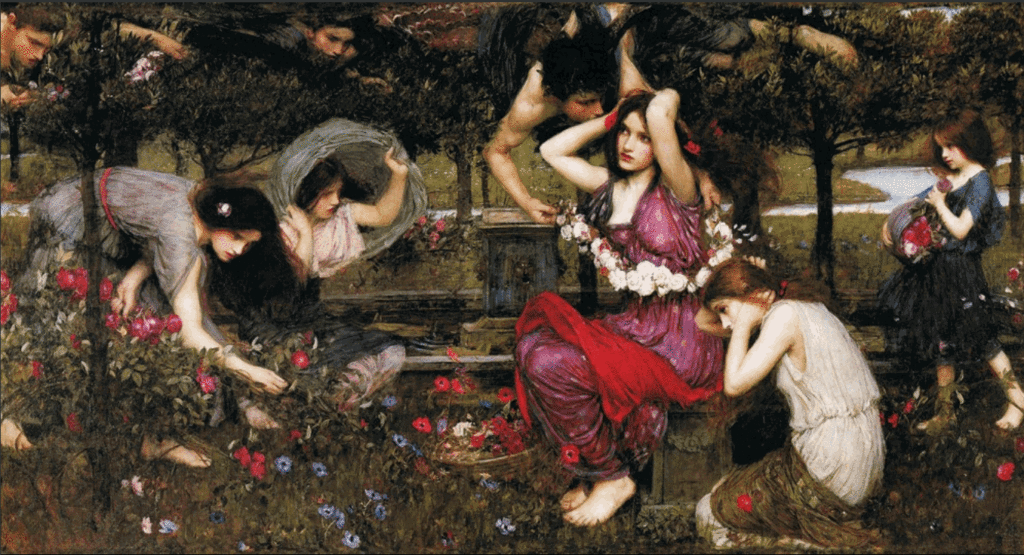
From whence he “kissed” her and turned her into a Flora.
Oh, those lustful Gods.
The Awakening of Adonis
Adonis was the mortal lover of the goddess Aphrodite in Greek mythology. In Ovid's first-century AD telling of the myth, he was conceived after Aphrodite cursed his mother Myrrha to lust after her own father, King Cinyras of Cyprus. Myrrha had sex with her father in complete darkness for nine nights, but he discovered her identity and chased her with a sword. The gods transformed her into a myrrh tree and, in the form of a tree, she gave birth to Adonis. Aphrodite found the infant and gave him to be raised by Persephone, the queen of the Underworld. Adonis grew into an astonishingly handsome young man, causing Aphrodite and Persephone to feud over him, with Zeus eventually decreeing that Adonis would spend one third of the year in the Underworld with Persephone, one third of the year with Aphrodite, and the final third of the year with whomever he chose. Adonis chose to spend his final third of the year with Aphrodite. -Wikipedia
Those were lustful times back then.
Waterhouse’s great mythological subject The Awakening of Adonis (Collection of Lord Lloyd-Webber) was painted in 1899.
However, it was not finished in time to send to the Royal Academy that year, and was therefore held over to the summer exhibition of 1900.
On that occasion it was recognised as one of the artist’s most powerful and characteristic works and one that aimed, in the words of one reviewer, ‘at representing the passionate emotions of an historic tragedy in a highly dramatic fashion’ (Athenaeum, 1900, p.568).
The Awakening of Adonis takes its subject from the ancient fable, retold by Apollodorus, Hyginus and Ovid, which tells how Adonis was the child of Myrrha and her father Theias, the king of Syria. The goddess Venus had encouraged this incestuous union and, when Adonis was born from the trunk of the myrrh tree into which his mother had been transformed, it was she who took care of him, entrusting him to Persephone, goddess of the Underworld. The child grew up to be so beautiful that Persephone found that she could not bear to return him to Venus, leading to a dispute between the two. This was settled by Zeus, who decided that Adonis should spend four months of the year with Venus and another four with Persephone. The remaining third of the year he might spend with whichever of the two goddesses he preferred. Venus used the power of magic to cause him to want her rather than Persephone. In Waterhouse’ painting the beautiful boy is awakened with a kiss from Venus in her Elysian pleasure-garden. Cupid, the god of love, blows on a torch to rekindle a flame, and is accompanied by a band of putto holding flowers. White doves take to the air and the garden is fecund with roses (symbols of Venus) and anemone flowers that were said to grow from the blood of the dying Adonis. The mythological legend of Adonis, as represented in the present painting, is therefore symbolic of the renewal of life, vigour, and desire at the arrival of spring. – From Sotheby’s catalogue.
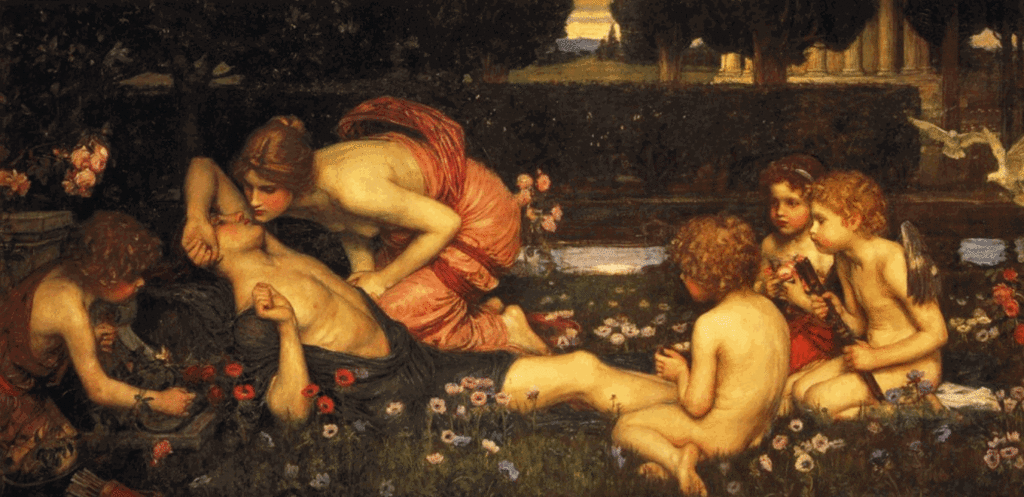
A Naiad
In Greek mythology, the Naiads are a type of female spirit, or nymph, presiding over fountains, wells, springs, streams, brooks and other bodies of fresh water. -Wikipedia
Naiad, (from Greek naiein, “to flow”), in Greek mythology, one of the nymphs of flowing water—springs, rivers, fountains, lakes.
The Naiads, appropriately in their relation to freshwater, were represented as beautiful, lighthearted, and beneficent.
Like the other classes of nymphs, they were extremely long-lived, although not immortal.
...in Greek mythology, naiads supposedly drowned the young men with whom they became enamored. -Naiad | Definition of Naiad by Merriam-Webster
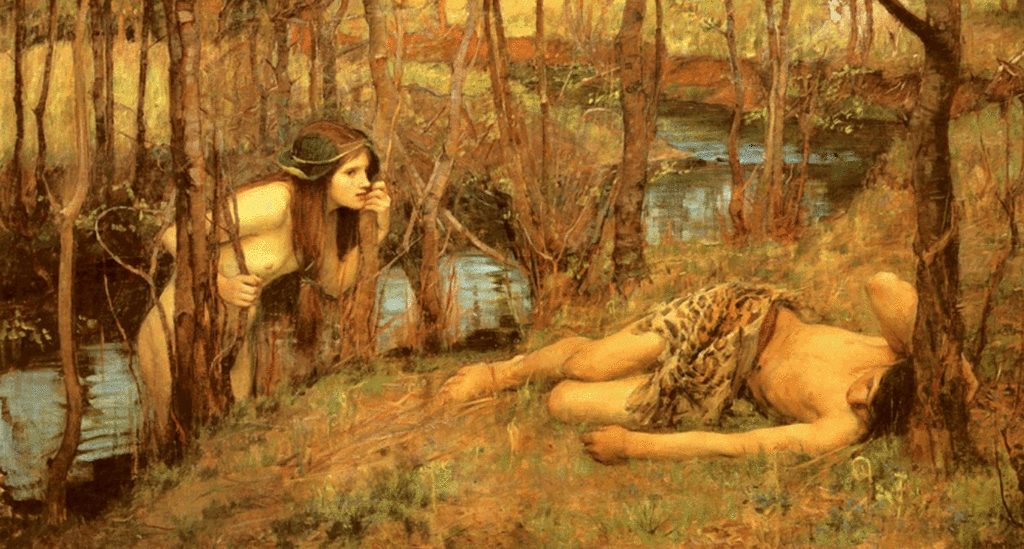
Variations…
- Nymph. Nymph, in Greek mythology, any of a large class of inferior female divinities. The nymphs were usually associated with fertile, growing things, such as trees, or with water. They were not immortal but were extremely long-lived and were on the whole kindly disposed toward men. They were distinguished according to the sphere of nature with which they were connected.
- The Oceanids, were sea nymphs.
- The Nereids inhabited both saltwater and freshwater; the Naiads presided over springs, rivers, and lakes.
- The Oreads (oros, “mountain”) were nymphs of mountains and grottoes.
- The Napaeae (nape, “dell”) and the Alseids (alsos, “grove”) were nymphs of glens and groves.
- The Dryads or Hamadryads presided over forests and trees.
- Myth. Myth, a symbolic narrative, usually of unknown origin and at least partly traditional, that ostensibly relates actual events and that is especially associated with religious belief. It is distinguished from symbolic behaviour (cult, ritual) and symbolic places or objects (temples, icons). Myths are specific accounts of gods or superhuman beings involved in extraordinary events or circumstances in a time that is unspecified but which is understood as existing apart from ordinary human experience.
Good Neighbours
I love this picure for it’s technique, attention to detail, and the timelessness of it. I think that it is a “treasure”.

Hylas and the Nymphs
Hylas, in ancient Greek legend, son of Theiodamas (king of the Dryopians in Thessaly), favourite and companion of Heracles on the Argonautic expedition. Having gone ashore at Cios in Mysia to fetch water, he was dragged down by the nymphs of the spring in which he dipped his pitcher. -Hylas | Greek mythology | Britannica
The story isn’t long, but it does seem important. It has continued to be represented in art and in story (though there have DEFINITELY been some changes made to make it fit into the new cultures), but it was also super important in ancient Greece, where sacrifices were made in a festival in his honor. Rituals were done in his name.
This story is found slightly more fully in Book One of the Argonautica, and in that version, it is clarified that he walked off from the group hoping to get water to make a meal for his man.
His man, of course, was Herakles.
Now, we should sidenote here that Herakles definitely liked a sexy youth or two. Hylas is the most famous of his beloveds, but by no means the only one.
This does not mean that Heracles was gay. It does not even mean that he was bi. These terms did not even exist. Although I think this topic is fascinating, I will suffice it to say that the relationship between Hylas and Herakles was very normal and even celebrated in ancient Greek culture.
So it would make sense that Hylas (the beloved and “passive” partner) would be getting water to make something nice before Herakles got back to camp.
But, unfortunately for him, he was deep in Pegae territory.
Now, most of them were away guarding the forest for a nymphaic jamboree they were planning on throwing for Artemis, but one chick was left to hold down the fort, I suppose and when she saw Hylas, standing there in the moonlight (moonlight is like mood lighting …) lookin’ all pretty and sexy, her heart just went pitter pat.
It didn’t help that Aphrodite was there aiding the whole process (didn’t help Hylas that is).
And if you have read about the nymphs, then you know, this is NOT a good situation our young man is walking into.
The authors have already established that he’s kinda delicate, that he’s relatively passive in his relationships, he’s young, and he’s mortal.
Said nymph may appear delicate, but she is super powerful compared to this dude, and no good can come from relationships where women hold more power than men – at least not in ancient Greek mythology.
…
You already know what happens next, but I’ll spin in out all poetic like.
Hylas, dipping like a dancer, kneels and drags his pitcher through the water. And as his arm went into the water, her arm came out and wrapped around his neck, pulling him closer for a kiss.
Truly, our source must have been a mouse watching from land, because the story ends there.
We do not even know if she got her kiss, because when Hylas tumbled into the water, it was the last anyone ever heard of him.
Sure, Herakles searched the island for a long time, but eventually, the crew of the Argo gave up and continued their quest without him.
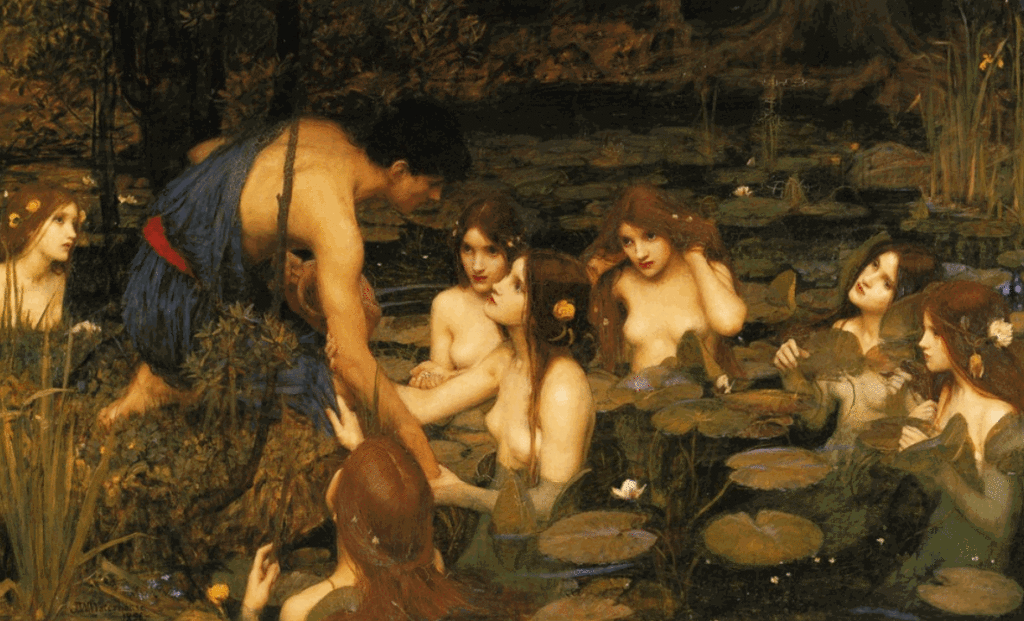
The moral of the story?
Don’t be like Hylas.
Saint Eulalia
Eulalia was a Christian girl who had the cosmic misfortune of being born in Barcelona in the third century after Jesus, during the reign of Roman emperor Diocleciano.
Diocleciano was the kind of emperor who didn’t like Christians and wanted them all to recant their faith.
Unfortunately, Eulalia was of the mindset that she’s an independent girl who don’t need no emperor telling her who to worship.
Diocleciano didn’t like that.
So her ordered that Eulalia suffer 13 tortures, one for each of her years on earth. Yep, she was 13 when she was tortured to death and subsequently martyred.
ST EULALIA 13 TORTURES
Her tortures were (because we’re a morbid bunch when fucked-up shit happened to ancient people):
- Imprisonment in a tiny prison,
- Being whipped,
- Tearing her skin in strips,
- Making her walk barefoot on burning embers,
- The cutting off of her breasts,
- Rubbing her wounds with rough stones,
- Branding her with cast iron,
- Throwing boiling oil and,
- Molten lead over her,
- Submerged in burning lime,
- Locked in a flea box,
- Rolled down a hill, naked, in a barrel full of knives, swords and glass, and finally,
- Crucified in the form of a cross.
After all that she was decapitated and apparently a white dove flew from her neck. This is why there are 13 geese in the Barcelonan cathedral of Saint Eulalia. (doves, geese, whatevers).
Holy smokes!
And now, after all of that, she gets a relatively crappy festival compared to Merce’s amazing one? How flaky are the Catalans? Poor Eulalia goes through all that and then they try and replace her because she maybe didn’t chase off some insects? Give us a break!
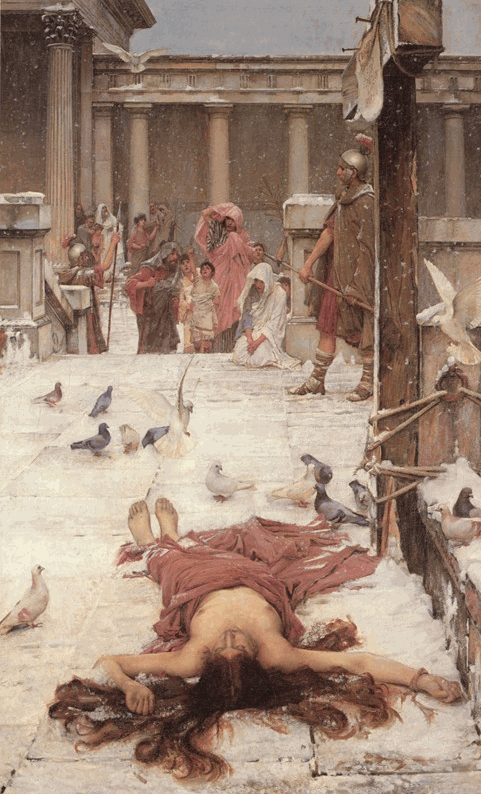
The Story and History of Saint Eulalia The story and history of Saint Eulalia. Saint Eulalia was a native of Merida, in Spain. She was but twelve years old when the bloody edicts of Diocletian were issued. Eulalia presented herself before the cruel judge Dacianus, and reproached him for attempting to destroy souls by compelling them to renounce the only true God. The governor commanded her to be seized, and at first tried to win her over by flattery, but failing in this, he had recourse to threats, and caused the most dreadful instruments of torture to be placed before her eyes, saying to her: "All this you shall escape if you will but touch a little salt and frankincense with the tip of your finger." Provoked at these seducing flatteries, our Saint threw down the idol, and trampled upon the cake which was laid for the sacrifice. At the judge's order, two executioners tore her tender sides with iron hooks, so as to leave the very bones bare. Next lighted torches were applied to her breasts and sides; under which torment, instead of groans, nothing was heard from her mouth but thanksgivings. The fire at length catching her hair, surrounded her head and face, and the Saint was stifled by the smoke and flame. -St. Eulalia of Merida - Saints & Angels - Catholic Online
Mariamne Leaving the Judgement Seat of Herod
Things were totally and completely fucked-up in the old days.
King Herod of Judea Herod I ( c. 74/73 BCE – 4 BCE/1 CE), also known as Herod the Great, was the King of Judea from 37 to 4 BC. At the time Judea was a client state of Rome. During his 33 year reign, Herod was an excellent administrator. But he is most famous for the Bible account of his killing the boys of Bethlehem. -Herod the Great
Herod was an Idumaenean, from the Land of Edom, a desert region of nomads to the south of Judaea. His father was Antipater, who became a trusted procurator of Judaea, and his mother was Kupros, a woman of Arab descent.
At that time the King of Judaea was Hyrcanus II.
He was from the family of Hasmoneans, a popular nationalist, Jewish family who had been priests and Kings of the area from about the second century BC.
Antipater was, in his new position and friendship with King Hyrcanus II able to secure good jobs for his sons.
One of them, Phasael was made prefect of Jerusalem and the other son, Herod, was given the job of military prefect of Galilee.
Herod, now moving in the royal circles, caught the eye of Mariamne, the granddaughter of Hyrcanus II and, after divorcing his wife Doris, they became engaged to be married.
However, in 40 BC things took a turn for the worse as the Parthians invaded the area and set up Antigonus, another Hasmonaean, as King.
As Jerusalem fell, Herod escaped with his family but Hyrcanus and Phasael were captured.
After making sure that his family were safe he set off for Rome where he persuaded the Roman senate to give him the title, ‘King of the Jews’, and to pledge himself to return and take Judaea back under Roman allegiance.
He returned to the Palestine region and starting from Galilee he slowly took control of his kingdom.
In just three years he succeeded in capturing Antigonus, and with his new bride Mariamne, the grandaughter of Hyrcanus, he began to rule his kingdom.
King Herod began to rebuild the temple.
He established new towns and harbours and brought neighbouring regions into his own kingdom and in alliance to Rome. However, this apparently successful story of how a member of an Idumaenean nomadic family became the ruler of a kingdom was unfortunately marred by Herod’s chronic insecurity.
This was partly because the Jews did not like him because he was an Idumaenean.
Although he practised Judaism, it was not thought that he gave it much priority.
In modern terms he was a multi-faith enthusiast, giving credence to other religious ideas which in Jewish eyes diluted his conviction to the faith .
Also against him was his overthrowing of Antigonus from the popular Hasmonean family.
He tried to overcome this by marrying Mariamne, King Hyrcanus II’s grandaughter, and therefore a Hasmonean princess.
He also curried favour with the people by placing Hasmoneans in important positions in his court.
This had the affect of making people tolerate his kingship but it also made him feel under even more threat from the very people he had promoted. and led to increasing insecurity.
Having reached the heights of Kingship, he never felt totally secure and he saw conspiracy and plotting from every quarter.
(uh oh…)
First to be killed on his orders was his brother-in-law and high priest, Aristobulus.
While answering the charge of his murder in Egypt he gave the order to his uncle Joseph that if he should die, then his wife and her mother were to be executed.
Herod managed to talk his way out of the murder charge, but on his return to Jerusalem found that his wife had learned his arrangement with Joseph.
Needless to say Mariamne was none too pleased to hear of this arrangement!
…!
Herod began to wonder why Joseph had told Mariamne, and came to the wrong conclusion they were having an affair.
In fact Joseph had told her of the plan in order to demonstrate Herod’s love for her.
However, despite the total lack of evidence Joseph was executed.
Herod was very much in love with Mariamne, but with jealous accusations from his other wives and Mariamne’s increasing coldness towards him, he eventually persuaded himself to have her executed too.
He regretted it straight away and became filled with guilt, making himself mentally and physically ill.
Thinking that Herod was about to die, Alexandra, Mariamne’s mother made arrangements to put Herod’s children by Mariamne, Alexander and Aristobulus, on the throne.
She too was then executed for her presumption!
Herod had 10 wives altogether and towards the end of Herod’s life, Antipater, the eldest son by his first wife began to realise that he was not favoured to take over from his father.
He was deeply jealous of the sons of Mariamne, and in order to discredit them he accused his two step brothers of treachery and, believing him, Herod had them both executed too.
Antipater must have thought he had got away with it, but just before Herod died, Antipater was executed as well, accused of trying to accelerate his death.
Signing Antipater’s death warrant, Augustus Caesar remarked that he would rather be Herod’s pig than Herod’s son!
Just before his death, Herod, realising that when he died there would be no great mourning, sent letters to the principle heads of every family in Judaism demanding their presence on pain of death.
Having got them to Jerusalem, Herod ordered them to be locked up in the horse-racing ground.
He then gave the orders to his sister that upon his death they were all to be executed.
Thus making sure that the whole nation would mourn when he died, albeit not for him.
(Talk about a fucked-up plan!)
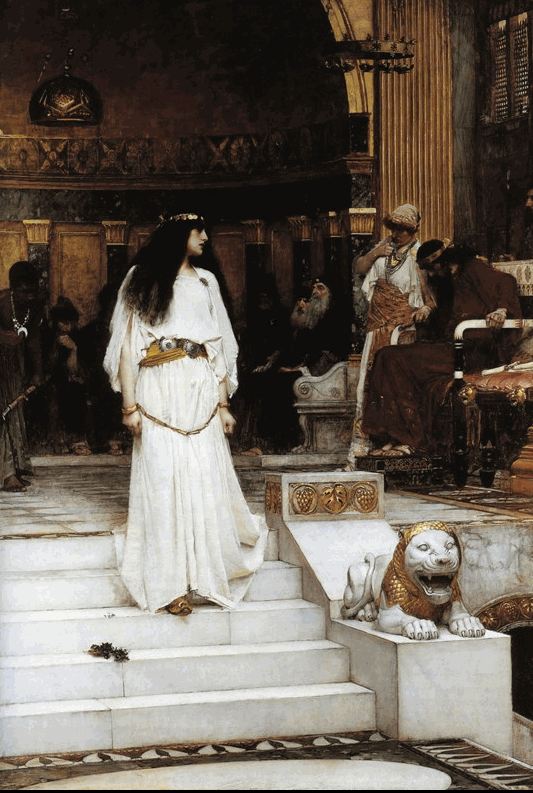
Fortunately, when Herod died, his sister released the imprisoned Jews and allowed them to return home. Herod died 37 years after being declared ‘King of the Jews’, leaving four sons, to whom was given one quarter of his kingdom each.
Diogenes
Diogenes of Sinope (c. 404-323 BCE) was a Greek Cynic philosopher best known for holding a lantern (or candle) to the faces of the citizens of Athens claiming he was searching for an honest man.
He was most likely a student of the philosopher Antisthenes (445-365 BCE) and, in the words of Plato (allegedly), was “A Socrates gone mad.” He was driven into exile from his native city of Sinope for defacing currency (though some sources say it was his father who committed the crime and Diogenes simply followed him into exile).
Diogenes came to Athens where he met Antisthenes who at first refused him as a student but, eventually, was worn down by his persistence and accepted him.
Like Antisthenes, Diogenes believed in self-control, the importance of personal excellence in one’s behavior (in Greek, arete, usually translated as `virtue’), and the rejection of all which was considered unnecessary in life such as personal possessions and social status.
He was so ardent in his beliefs that he lived them very publicly in the market place of Athens. He took up residence in a large wine cask (some sources claim it was an abandoned bathtub), owned nothing, and seems to have lived off the charity of others.
He owned a cup which served also has a bowl for food but threw it away when he saw a boy drinking water from his hands and realized one did not even need a cup to sustain oneself.
It seems clear that Diogenes believed what people called `manners’ were simply lies used to hide the true nature of the individual.
He was known for brutal honesty in conversation, paid no attention to any kind of etiquette regarding social class, and seems to have had no problem urinating or even masturbating in public and, when criticized, pointed out that such activities were normal and that everyone engaged in them but hid in private what he did openly.
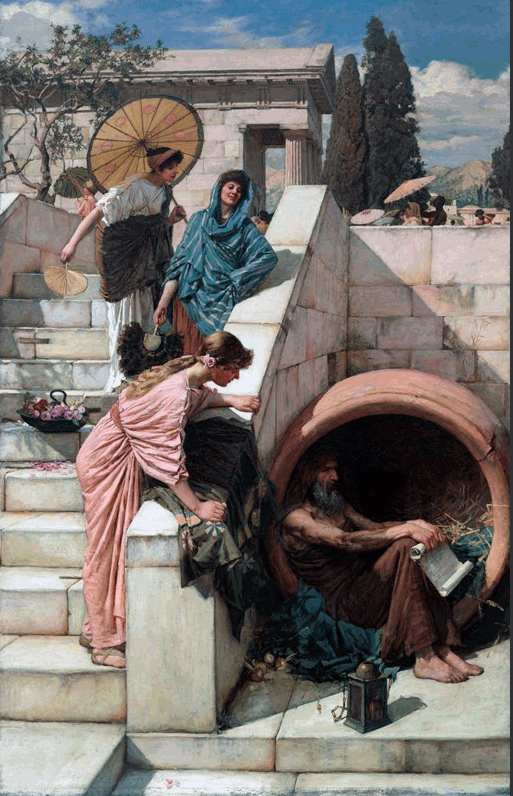
Diogenes was a widely misunderstood man.
Pandora
In Greek mythology, Pandora was the first human woman created by Hephaestus on the instructions of Zeus. As Hesiod related it, each god co-operated by giving her unique gifts. Her other name—inscribed against her figure on a white-ground kylix in the British Museum—is Anesidora, "she who sends up gifts". -Wikipedia
When Prometheus stole fire from the gods, Zeus created Pandora as a punishment for mankind. One would think Zeus had doled out enough punishment after sentencing Prometheus to spend an eternity chained to a rock while birds pecked at his liver, but it seemed the king of the gods had more in store.
Zeus commissioned the god Hephaestus to sculpt a beautiful woman out of clay, and she was given gifts from a few gods before she was sent down to fulfill her purpose. Pandora was sent to be the wife of Epimetheus (Prometheus’s brother), and only brought one thing with her: a container full of all the world’s evils.
Of course, Zeus didn’t tell Pandora what was inside the box – instead, he told her to never open it, and then gave the key to her husband, because when you tell someone to not do something, you put temptation as close as possible. Can you blame her for sneaking a peek?
Pandora's box is an artifact in Greek mythology connected with the myth of Pandora in Hesiod's Works and Days. In modern times an idiom has grown from it meaning "Any source of great and unexpected troubles", or alternatively "A present which seems valuable but which in reality is a curse". Later depictions of the fatal container have been varied, while some literary and artistic treatments have focused more on the contents of the idiomatic box than on Pandora herself. The container mentioned in the original story was actually a large storage jar but the word was later mistranslated as "box". -Wikipedia
Like any rational creature, Pandora’s curiosity was piqued when she was given a secret container, told never to open it, and sent to earth to marry a stranger who held the key to this mystery vessel. Unfortunately, the temptation was just too much and it was this curiosity that unleashed all the world’s evils.
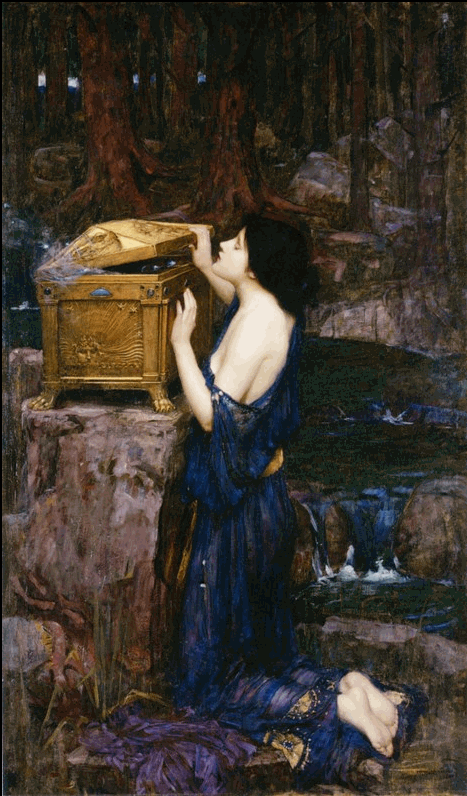
The list of items released from Pandora’s box are a handful: illness, worry, crime, hate, envy… basically any bad thing you could think of. They flew out of the box like little bugs, and Pandora tried to shut it back up as quickly as she could. She did, according to some of the versions of her myth, manage to trap one important thing inside: hope.
It is disputed why Zeus would even put hope in a vessel of evils. One rationale is that Zeus wasn’t the worst, and snuck hope in there as some sort of nicety in the midst of all the other horrors. Another is that Zeus meant for hope to remain in the box, to make the people suffer even more, and make them understand why they should never cross him again.
When Zeus sent Pandora to Earth, he married her off to Prometheus’s brother, Epimetheus. It seems odd that Zeus would gift a beautiful woman to the brother of someone he hated, but Pandora was supposed to be a punishment, so maybe it was part of his bigger plan. In fact, Prometheus warned his brother not to accept any gifts from the gods, but Epimetheus was too drawn in by Pandora’s beauty. She was crafted by the gods, after all.
Zeus entrusted Epimetheus with the key to Pandora’s box, which he refused to give to her no matter how hard she begged. So, eventually, Pandora snuck it away from him as he slept and unlocked the box herself (other versions of the myth also say Pandora simply broke the seal of the pithos).
Nymphs finding the Head of Orpheus
Nymphs Finding The Head of Orpheus is one of his most dramatic. The painting depicts two curious nymphs sitting by a small waterfall watching the head of Orpheus as it floats in a pool of water among the lily pads. A beautiful gift for fans of John William Waterhouse, Mythological Paintings, Orpheus, and Fantasy art -Nymphs Finding The Head of Orpheus
Orpheus is a figure from ancient Greek mythology, most famous for his virtuoso ability in playing the lyre or kithara.
His music could charm the wild animals of the forest, and even streams would pause and trees bend a little closer to hear his sublime singing. He was also a renowned poet, travelled with Jason and the Argonauts in search of the Golden Fleece, and even descended into the Underworld of Hades to recover his lost wife Eurydice.
Orpheus was seen as the head of a poetic tradition known as Orphism where, according to some scholars, adherents performed certain rituals and composed or read poems, texts, and hymns, which included an alternative view of humanity’s origins. Orpheus is widely referenced in all forms of ancient Greek art from pottery to sculpture.
He had quite an interesting life…
- A member of Jason’s expedition to find the Golden Fleece.
- Orpheus married Eurydice (aka Agriope).
- Eurydice died, in some accounts, on her wedding night.
- Orpheus followed his love down to Hades, the Greek Underworld.
- He was able to rescue her, provided he would not glance behind.
- He did, and lost her.
- He never got over her and roamed the forests of Thrace.
Orpheus’ misery would soon end, though, when he was set upon by a group of frenzied Maenads (the female followers of Dionysos, the god of wine).
They stoned him to the ground and ripped him to pieces for his lack of merriment.
According to Plutarch (c. 45-50 – c. 120-125 CE), the Maenads were punished for their crime by being turned into trees. Other Thracian women had their bodies tattooed by their husbands as a warning not to repeat such a crime – a cultural practice in the region stretching from antiquity to modern times.
And thus…
… in the forests of Thrace…
…Nymphs find the stoned head of Orpheus.
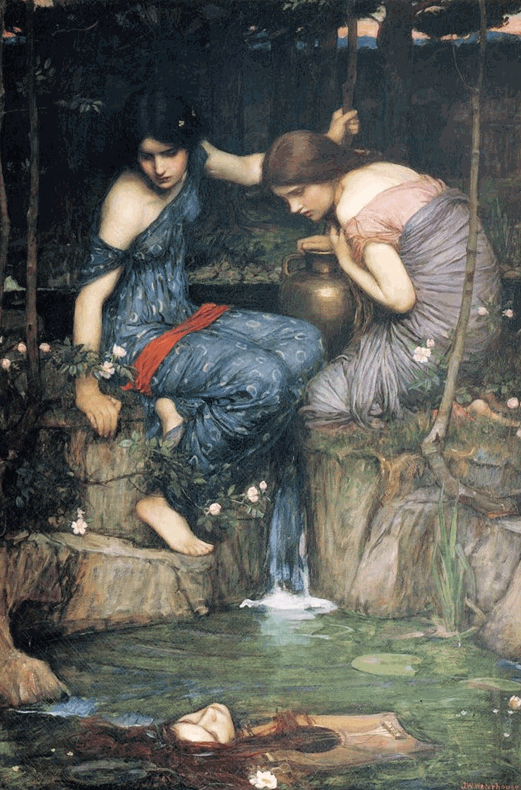
The Orange Gatherers
It’s just a nice painting. I love the technique and the composition.
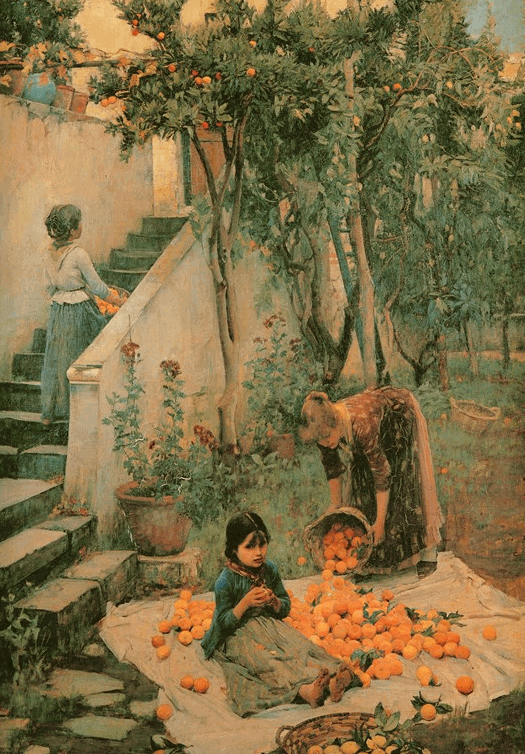
At Capri
And finally, I’ll end this post with another nice printing. There might be a story abhind it, but I don’t really know what it is. I just love the colors and composition.
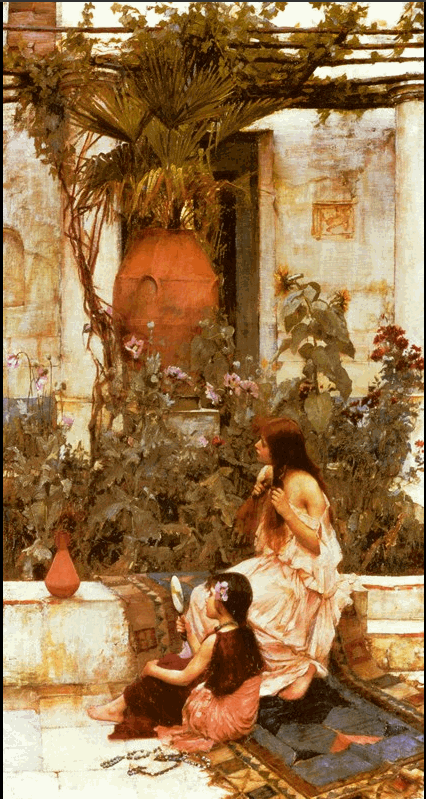
Do you want more?
I have more posts in my Art Index here…
ARTArticles & Links
You’ll not find any big banners or popups here talking about cookies and privacy notices. There are no ads on this site (aside from the hosting ads – a necessary evil). Functionally and fundamentally, I just don’t make money off of this blog. It is NOT monetized. Finally, I don’t track you because I just don’t care to.
To go to the MAIN Index;
Master Index.
- You can start reading the articles by going HERE.
- You can visit the Index Page HERE to explore by article subject.
- You can also ask the author some questions. You can go HERE .
- You can find out more about the author HERE.
- If you have concerns or complaints, you can go HERE.
- If you want to make a donation, you can go HERE.
Please kindly help me out in this effort. There is a lot of effort that goes into this disclosure. I could use all the financial support that anyone could provide. Thank you very much.

